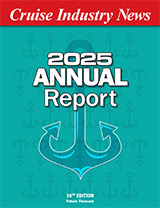“We’re easily talking 100 percent gains over current mobile-phone driven revenue on cruise ships,” said Ole-Kristian Sivertsen of Maritime Communications Partner (MCP).
The smartphone is the fastest spreading technology in human history, but just how can cruise lines tap into this revolution? “The opportunities start before your guests get on board and they don’t stop when they’re unpacking their bags back home,” added Sivertsen, Senior VP, Business Development and Sales, at MCP.
Revenue is increased by providing mobile services, by increasing onboard sales and by tapping into new source markets.
“As soon as you can imagine it and make it happen for them, they will expect it to always be there and you have just redefined cruising and given your company leadership.”
Every onboard activity area can benefit directly from increased focus on smartphone opportunities. “When you want to market an excursion what do you do?” asked Sivertsen. “Sending a simple promotional message is just one small part of what’s possible. Think holistically and you can open up much more value.”
The announcement of an excursion can be combined with a video experience like a virtual tour that can be combined with targeted up-sell. Each contact is connected to a revenue-generating opportunity, and guests can be reached out to with initiatives like this even before they board the cruise ship.
When arriving at destinations, many cruise lines offer promotions for selected retailers in the port. An alternative to offering these local retailers advertising space onboard could be to offer them delivery of mobile quick response (QR) codes or coupons to targeted groups onboard the ship, charging them a price per guest reached.
“Think about onboard gaming or the evening bingo in the main lounge. By making the tickets available on mobile devices, guests could buy them and play even if they are in their cabin – but in order to stimulate them to be in the lounge where they also spend money on food and beverages (F&B), it could be set up so that they get two tickets for the price of one if they are in the lounge,” said Sivertsen.
Pre-travel uses of smart promotion can include pre-ordering of F&B, pre-booking of spa services or shore excursions. Up-sell on restaurants or order that nice bottle of champagne to be on ice in the cabin upon arrival.
“A post journey opportunity could be to reach out with an invitation to purchase photos and to use this as a means of viral marketing,” he noted. By allowing guests to purchase photos via their mobile devices, you could offer a discount for pictures that they share on social networks. The advantage to you is the cruise experience gets broadcast virally throughout your passengers’ networks.
“Viral marketing is huge. Take the example of Levi Strauss, who uses social media to offer location-specific deals. In one instance, direct interactions with just 400 consumers led 1,600 people to turn up at the company’s stores — a prime example of social media’s word-of-mouth effect.”
Most developed regions are already way beyond 50 percent adoption of smartphones. In July this year, two in five accessed travel content from their devices and four out of five are using them for shopping. “It is not just young people, growth in smart phone use by older age groups is stronger than ever.”
90 percent of text messages are read within three minutes of delivery, and most smartphone users actively access social media.
One of the biggest challenges for cruise lines is to deal with diverse customers, different languages and cultures. “If you have a technology that is time and location aware and dynamically adapts content, look and feel to the real-time context, this could be the foundation for becoming one global local cruise company – or as HSBC says: The World’s Local Bank,” Sivertsen added.
Cruise Lines have an array of devices available for entertainment, information and marketing initiatives. From cabin TV and phone to smartphones, iPads, and PCs. “Imagine delivering content from a single platform seamlessly to any device at any moment,” said Sivertsen.
There are practically no bill shocks associated with onboard mobile phone use any more,” Sivertsen explained.
Today some 30 percent of all guests actually use mobile services onboard. Current trends show a decrease in the number of voice minutes per user and a slight decrease in SMS but an explosion in mobile data, keeping total revenues growing.
“An increase from 1,000 to 1,500 passengers using their mobile for some calls, sms’s and internet access, easily represents 100 percent total growth in revenue just from providing the service,” Sivertsen continued.
Company leadership is imperative to realizing and unleashing the full potential of mobile services.
Sivertsen explains: “Here, the 80-20 rule comes into play. The importance of the technology itself is probably less than 20 percent – more than 80 percent is down to people, culture, processes and organization; and that comes under the realm of company leadership.”
“It is imperative to have a full scale, high quality mobile service on cruise ships that extends across all silos and departments of a company. The alignment of the company’s overall mobile strategy must be in place to maximize revenue generation and positively influence guest behavior and experiences,” Sivertsen concluded.



